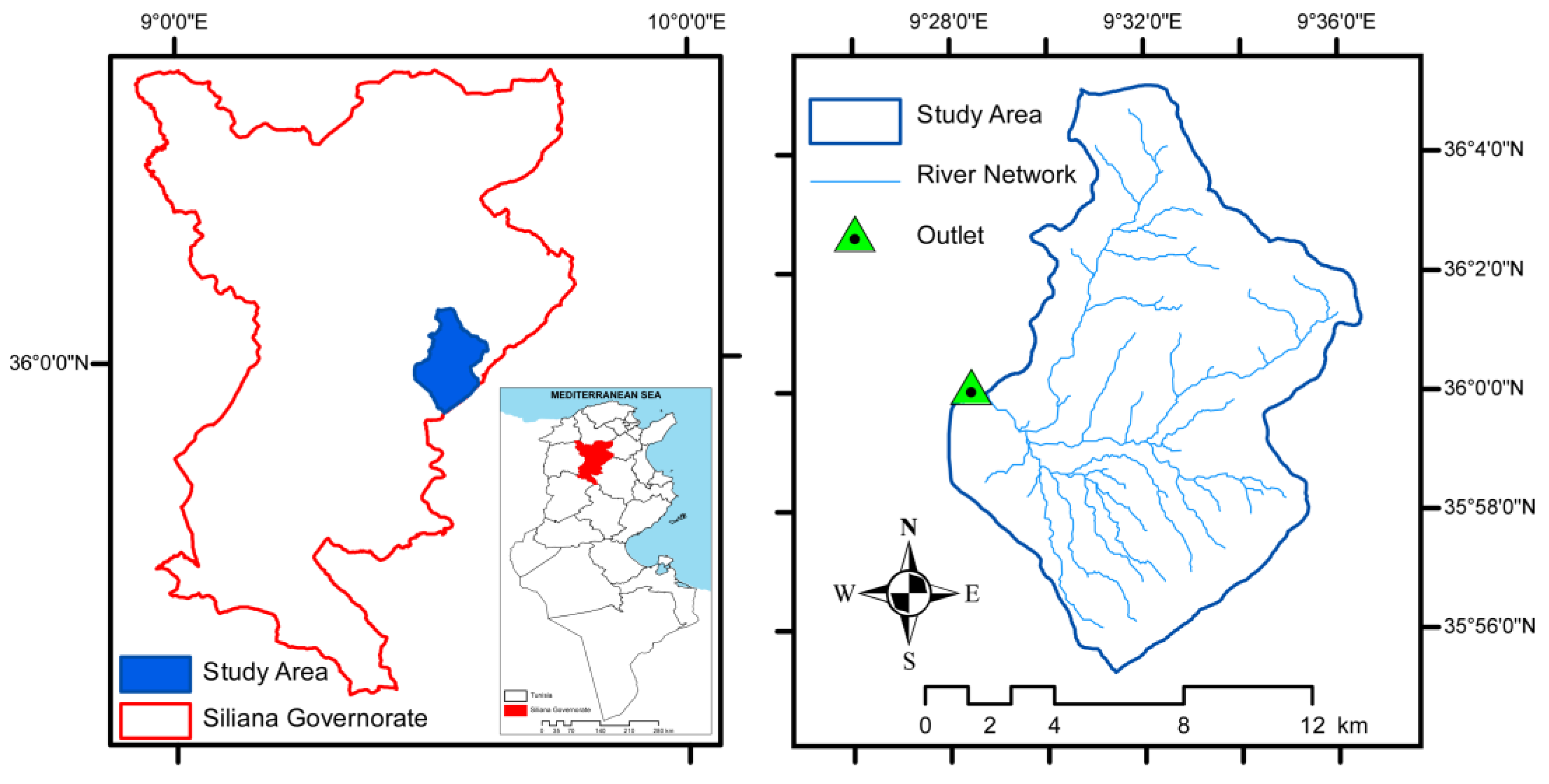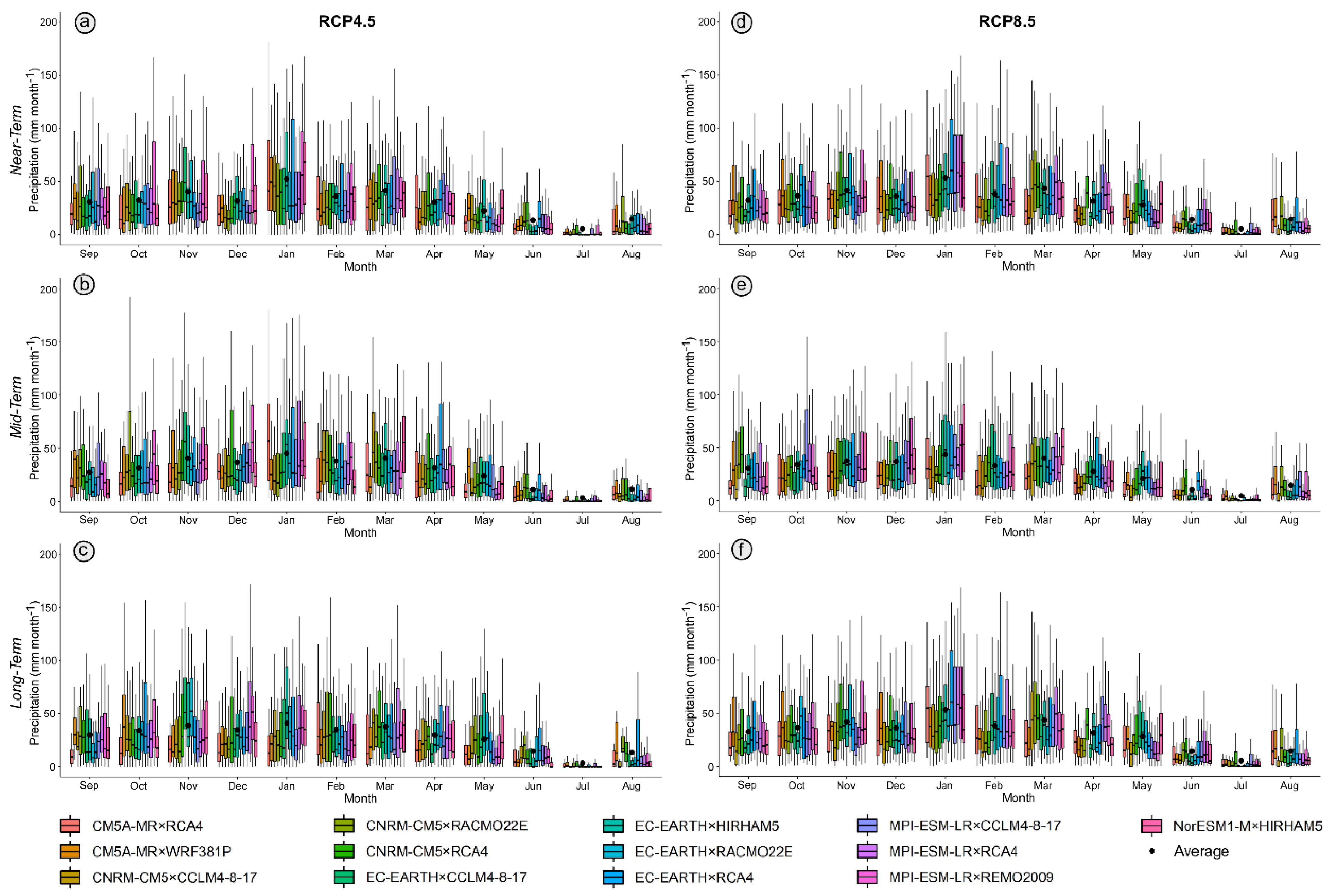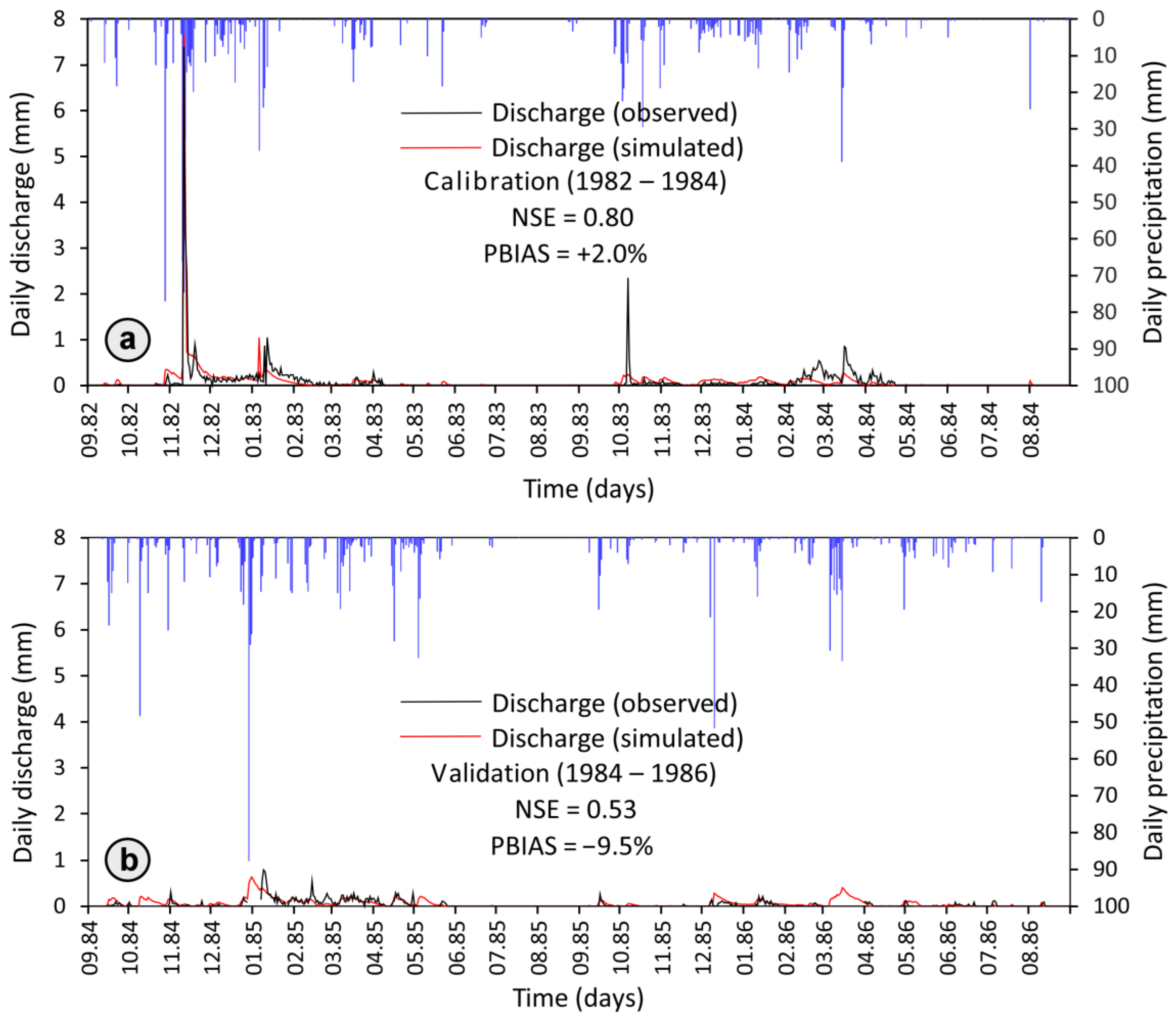Assessment of Climate Change Impact on Discharge of the Lakhmass Catchment (Northwest Tunisia)
Abstract
:1. Introduction
2. Materials and Methods
2.1. Catchment Characteristics
2.2. Data Analysis
2.3. HBV-Light Model and Input Data
| Data Type | Data Description | Resolution | Period/Date | Source |
|---|---|---|---|---|
| Meteorological | Air temperature (°C) (1 climate station) | Daily | 1980–2015 | National Institute of Meteorology (INM) |
| Precipitation (mm) (3 rainfall stations) | Daily | 1976–2012 | General Directory of Water Ressources (DGRE) | |
| Hydrological | Discharge (mm) (1 gauging station) | Daily | 1980–2015 (outlet) | General Directory of Dams, Studies and Hydraulic structures (DGBETH) |
| Geographical | Digital Elevation Model (DEM) | 30 m | USGS | |
| Soil type | 1:50,000 | 2002 | Agricultural Map of Siliana (2002) | |
| Land use | 100 m | 2014 | Partnership ESIM-UCLouvain (WBI) [36] |
2.4. Hydrological Model Calibration and Validation
2.5. Model Performance Evaluation
2.6. Future Climate Projections
3. Results and Discussion
3.1. Model Performance
3.2. Best-Optimized Model Parameters
3.3. Effects of Future Climate
3.4. Discussion
4. Conclusions
Author Contributions
Funding
Institutional Review Board Statement
Informed Consent Statement
Data Availability Statement
Acknowledgments
Conflicts of Interest
References
- Tsanis, I.K.; Koutroulis, A.G.; Daliakopoulos, I.N.; Jacob, D. Severe climate-induced water shortage and extremes in Crete. Clim. Chang. 2011, 106, 667–677. [Google Scholar] [CrossRef]
- Lionello, P.; Scarascia, L. The relation between climate change in the Mediterranean region and global warming. Reg. Environ. Chang. 2018, 18, 1481–1493. [Google Scholar] [CrossRef]
- Cramer, W.; Guiot, J.; Fader, M.; Garrabou, J.; Gattuso, J.P.; Iglesias, A.; Lange, M.A.; Lionello, P.; Llasat, M.C.; Paz, S.; et al. Climate change and interconnected risks to sustaina-ble development in the Mediterranean. Nat. Clim. Chang. 2018, 8, 972–980. [Google Scholar] [CrossRef] [Green Version]
- United Nations Environment Programme. Adaptation Gap Report 2020; UNEP: Nairobi, Kenya, 2021. [Google Scholar]
- Immerzeel, W.W.; Lutz, A.F.; Andrade, M.; Bahl, A.; Biemans, H.; Bolch, T.; Hyde, S.; Brumby, S.; Davies, B.J.; Elmore, A.C.; et al. Importance and vulnerability of the world’s water towers. Nature 2020, 577, 364–369. [Google Scholar] [CrossRef]
- United Nations Environment Programme. Making Peace with Nature: A Scientific Blueprint to Tackle the Climate, Biodiversity and Pollution Emergencies; UNEP: Nairobi, Kenya, 2021. [Google Scholar]
- Radoslav, S.D. The Paris Agreement on Climate Change: Behind Closed Doors. Glob. Environ. Polit. 2016, 16, 1–11. [Google Scholar]
- United Nations. Paris Agreement; United Nations: Paris, France, 2015. [Google Scholar]
- Yıldırım, Ü.; Güler, C.; Önol, B.; Rode, M.; Jomaa, S. Modelling of the Discharge Response to Climate Change un-der RCP8.5 Scenario in the Alata River Basin (Mersin, SE Turkey). Water 2021, 13, 483. [Google Scholar] [CrossRef]
- Lembaid, I.; Moussadek, R.; Mrabet, R.; Bouhaouss, A. Modeling Soil Organic Carbon Changes under Alternative Climatic Scenarios and Soil Properties Using DNDC Model at a Semi-Arid Mediterranean Environment. Climate 2022, 10, 23. [Google Scholar] [CrossRef]
- Rizzo, A.; Vandelli, V.; Gauci, C.; Buhagiar, G.; Micallef, A.S.; Soldati, M. Potential Sea Level Rise Inundation in the Mediterranean: From Susceptibility Assessment to Risk Scenarios for Policy Action. Water 2022, 14, 416. [Google Scholar] [CrossRef]
- Pulighe, G.; Lupia, F.; Chen, H.; Yin, H. Modeling Climate Change Impacts on Water Balance of a Mediterranean Watershed Using SWAT+. Hydrology 2021, 8, 157. [Google Scholar] [CrossRef]
- United Nations Environment Programme. State of the Environment and Development in the Mediterranean (SoED). Plan Bleu 2019. Available online: https://planbleu.org/soed/ (accessed on 20 September 2021).
- Tuel, A.; Eltahir, E.A.B. Why is the Mediterranean a Climate Change Hot Spot? J. Clim. 2020, 33, 5829–5843. [Google Scholar] [CrossRef]
- Allen, M.R.; Dube, O.P.; Solecki, W.; Aragón-Durand, F.; Cramer, W.; Humphreys, S.; Kainuma, M.; Kala, J.; Mahowald, N.; Mulugetta, Y.; et al. Framing and Context. In Global Warming of 1.5 °C. An IPCC Special Report on the Impacts of global warming of 1.5°C above Pre-Industrial Levels and Related Global Greenhouse Gas Emission Pathways, in the Context of Strengthening the Global Response to the Threat of Climate Change, Sustainable Development, and Efforts to Eradicate Poverty; Masson-Delmotte, V., Zhai, P., Pörtner, H.-O., Roberts, D., Skea, J., Shukla, P.R., Pirani, A., Moufouma-Okia, W., Péan, C., Pidcock, R., et al., Eds.; Cambridge University Press: Cambridge, UK; New York, NY, USA, 2018; p. 49. Available online: https://www.ipcc.ch/sr15/chapter/chapter-1/ (accessed on 17 August 2021).
- MedCC. Climate and Environmental Change in the Mediterranean Basin—Current Situation and Risks for the Future. First Mediterranean Assessment Report (MAR1); Cramer, W., Guiot, J., Marini, K., Eds.; Plan Bleu, UNEP/MAP: Marseille, France, 2020. [Google Scholar]
- Reinecke, R.; Müller Schmied, H.; Trautmann, T.; Andersen, L.S.; Burek, P.; Flörke, M.; Gosling, S.N.; Grillakis, M.; Hanasaki, N.; Koutroulis, A.; et al. Uncertainty of simulated groundwater recharge at different global warming levels: A global-scale multi-model ensemble study. Hydrol. Earth Syst. Sci 2021, 25, 787–810. [Google Scholar] [CrossRef]
- Seibert, J.; Vis, M.J.P. Teaching hydrological modeling with a user-friendly catchment-runoff-model software package. Hydrol. Earth Syst. Sci. 2012, 16, 3315–3325. [Google Scholar] [CrossRef] [Green Version]
- Engel, B.; Storm, D.; White, M.; Arnold, J.; Arabi, M. A Hydrologic/Water Quality Model Application Protocol. J. Am. Water Resour. Assoc. 2007, 43, 1223–1236. [Google Scholar] [CrossRef]
- Chaibou Begou, J.; Jomaa, S.; Benabdallah, S.; Bazie, P.; Afouda, A.; Rode, M. Multi-Site Validation of the SWAT-Model on the Bani Catchment: Model Performance and Predictive Uncertainty. Water 2016, 8, 178. [Google Scholar] [CrossRef]
- Chen, J.; Gao, C.; Zeng, X.; Xiong, M.; Wang, Y.; Jing, C.; Krysanova, V.; Huang, H.; Zhao, N.; Su, B. Assessing changes of river discharge under global warming of 1.5 °C and 2 °C in the upper reaches of the Yangtze River Basin: Approach by using multiple- GCMs and hydrological models. Quat. Int. 2017, 453, 63–73. [Google Scholar] [CrossRef]
- Moss, R.H.; Edmonds, J.A.; Hibbard, K.A.; Manning, M.R.; Rose, S.K.; Van Vuuren, D.P.; Wilbanks, T.J. The next generation of scenarios for climate change research and assessment. Nature 2010, 463, 747–756. [Google Scholar] [CrossRef]
- Dakhlaoui, H.; Djebbi, K. Evaluating the impact of rainfall–runoff model structural uncertainty on the hydrological rating of regional climate model simulations. J. Water Clim. Chang. 2021, 12, 3820–3838. [Google Scholar] [CrossRef]
- Boulmaiz, T.; Boutaghane, H.; Abida, H.; Saber, M.; Kantoush, S.A.; Tramblay, Y. Exploring the Spatio-Temporal Variability of Precipitation over the Medjerda Transboundary Basin in North Africa. Water 2022, 14, 423. [Google Scholar] [CrossRef]
- Bergström, S. Development and Application of a Conceptual Runoff Model for Scandinavian Catchments; Reports Hydrolgy 7; Swedish Meteorological and Hydrological Institute (SMHI): Norrköping, Sweden, 1976. [Google Scholar]
- Bergström, S. The HBV Model—Its Structure and Applications; Reports Hydrolgy 4; Swedish Meteorological and Hydrological Institute (SMHI): Norrköping, Sweden, 1992. [Google Scholar]
- M’chirgui, R.; Bargaoui, Z.; Bardossy, A. Incidence de l’incertitude pluviométrique sur la modélisation pluie-débit. In Soil-Vegetation-Atmosphere Transfer Schemes and Large-Scale Hydrological Models, Proceedings of the a Symposium Held during the Sixth IAHS Scientific Assembly, Maastricht, The Netherlands, 18–27 July 2001; IAHS: Oxfordshire, UK, 2001. [Google Scholar]
- Ouachani, R.; Bargaoui, Z.; Ouarda, T. Intégration d’un filtre de Kalman dans le modèle hydrologique HBV pour la prévision des débits. Hydrol. Sci. J. 2007, 52, 318–337. [Google Scholar] [CrossRef] [Green Version]
- Dakhlaoui, H.; Ruelland, D.; Tramblay, Y.; Bargaoui, Z. Evaluating the robustness of conceptual rainfall-runoff models under climate variability in northern Tunisia. J. Hydrol. 2017, 550, 201–217. [Google Scholar] [CrossRef]
- MEHAT. Schéma Directeur d’Amenagement de la Région Economique du Nord-Ouest; Ministère de l’Equipement de l’Habitat et de l’Amengament du Territoire: Tunis, Tunisia, 2010. [Google Scholar]
- MEHAT. Atlas du Gouvernorat de Siliana; Ministère de l’Equipement de l’Habitat et de l’Amengament du Territoire: Tunis, Tunisia, 2013. [Google Scholar]
- Strahler, A.N. Quantitative analysis of watershed geomorphology. Eos Trans. Am. Geophys. Union 1957, 38, 913–920. [Google Scholar] [CrossRef] [Green Version]
- Bergström, S. The HBV model. In Computer Models of Watershed Hydrology; Singh, V.P., Ed.; Water Resources Publications: Highlands Ranch, CO, USA, 1995; Chapter 13; pp. 443–476. [Google Scholar]
- Lindström, G.; Johansson, B.; Persson, M.; Gardelin, M.; Bergström, S. Development and test of the distributed HBV-96 hydrological model. J. Hydrol. 1997, 201, 272–288. [Google Scholar] [CrossRef]
- Seibert, J. Regionalisation of parameters for a conceptual rainfall-runoff model. Agric. For. Meteorol. 1999, 98–99, 279–293. [Google Scholar] [CrossRef]
- Sellami, H.; Vanclooster, M.; Khlifi, S.; Gara, A.; Mahjoub, M.R. Gestion des ressources en eau dans la Medjerda: Modélisation hydrologique. In Proceedings of the Renforcement de la Formation Supérieure et de la Recherche en Gestion Intégrée des Ressources en eau de la Medjerda, Medjez El Bab, Tunisia, 20 November 2014. [Google Scholar]
- Flügel, W.A. Delineating hydrological response units by geographical information system analyses for regional hydro-logical modelling using PRMS/MMS in the drainage basin of the River Bröl, Germany. Hydrol. Process. 1995, 9, 423–436. [Google Scholar] [CrossRef]
- Seibert, J. Estimation of parameter uncertainty in the HBV model. Hydrol. Res. 1997, 28, 247–262. [Google Scholar] [CrossRef]
- Bergestrôm, S.; Forsman, A. Development of a conceptual deterministic rainfall-runoff model. Hydrol. Res. 1973, 4, 147–170. [Google Scholar] [CrossRef]
- Nash, J.E.; Sutcliffe, J.V. River flow forecasting through conceptual models part I—A discussion of principles. J. Hydrol. 1970, 10, 282–290. [Google Scholar] [CrossRef]
- Yen, H.; Hoque, Y.; Harmel, R.D.; Jeong, J. The impact of considering uncertainty in measured calibration/validation data during auto-calibration of hydrologic and water quality models. Stoch. Environ. Res. Risk Assess. 2015, 29, 1891–1901. [Google Scholar] [CrossRef]
- Jacob, D.; Petersen, J.; Eggert, B.; Alias, A.; Christensen, O.B.; Bouwer, L.M.; Yiou, P. EURO-CORDEX: New high-resolution climate change projections for European impact research. Reg. Environ. Chang. 2013, 14, 563–578. [Google Scholar] [CrossRef]
- D’Oria, M.; Ferraresi, M.; Tanda, M.G. Historical trends and high-resolution future climate projections in northern Tuscany (Italy). J. Hydrol. 2017, 555, 708–723. [Google Scholar] [CrossRef]
- Teutschbein, C.; Seibert, J. Bias correction of regional climate model simulations for hydrological climate-change impact studies: Review and evaluation of different methods. J. Hydrol. 2012, 456–457, 12–29. [Google Scholar] [CrossRef]
- Thomson, A.M.; Calvin, K.V.; Smith, S.J.; Kyle, G.P.; Volke, A.; Patel, P.; Delgado-Arias, S.; Bond-Lamberty, B.; Wise, M.A.; Clarke, L.E.; et al. RCP4.5: A pathway for stabilization of radiative forcing by 2100. Clim. Chang. 2011, 109, 77–94. [Google Scholar] [CrossRef] [Green Version]
- Riahi, K.; Rao, S.; Krey, V.; Cho, C.; Chirkov, V.; Fischer, G.; Kindermann, G.; Nakicenovic, N.; Rafaj, P. RCP 8.5—A scenario of comparatively high greenhouse gas emissions. Clim. Chang. 2011, 109, 33–57. [Google Scholar] [CrossRef] [Green Version]
- Kouchi, D.H.; Esmaili, K.; Faridhosseini, A.; Sanaeinejad, S.H.; Khalili, D.; Abbaspour, K.C. Sensitivity of Calibrated Parameters and Water Resource Estimates on Different Objective Functions and Optimization Algorithms. Water 2017, 9, 384. [Google Scholar] [CrossRef] [Green Version]
- Jiang, S.; Jomaa, S.; Büttner, O.; Meon, G.; Rode, M. Multi-site identification of a distributed hydrological nitrogen model using Bayesian uncertainty analysis. J. Hydrol. 2015, 529, 940–950. [Google Scholar] [CrossRef]







| Characteristic | Unit | Value | Characteristic | Unit | Value |
|---|---|---|---|---|---|
| Catchment area | km2 | 126 | Soil type | ||
| Strahler’s stream order | – | 4 | Complex soil | % | 41 |
| Hydrology (1981–2012) | Brown limestone soil | % | 22 | ||
| Discharge at the outlet (daily mean) | m3/s | 2.99 | Vertisols | % | 15 |
| Precipitation (mean) a | mm/y | 452 | Ferralitic soil | % | 11.4 |
| Temperature (mean) | °C | 18 | Rendzina | % | 3.8 |
| Elevation range (m) | Lithosols | % | 3.7 | ||
| 512–600 | % | 42 | Waterbody | % | 1.8 |
| 600–700 | % | 29 | Isohumic soil and Regosols | % | 1.4 |
| 700–800 | % | 15 | Land use (in 2014) | ||
| 800–900 | % | 6 | Cropland | % | 67 |
| 900–1000 | % | 4 | Forest | % | 31 |
| 1000–1338 | % | 4 |
| GCMs | CNRM-CM5 | NorESM1-M | CM5A-MR | EC-EARTH | MPI-ESM-LR | |
| RCMs | ||||||
| CCLM4-8-17 | X | X | X | |||
| RCA4 | X | X | X | X | ||
| HIRHAM5 | X | X | ||||
| WRF381P | X | |||||
| RACMO22E | X | X | ||||
| REMO2009 | X | |||||
| Parameter | Physical Meaning | Vegetation Zone 1 | Vegetation Zone 2 |
|---|---|---|---|
| Snow Routine | |||
| TT (°C) | Temperature threshold of evaporation and snow accumulation | 2 | 2 |
| CFmax (mm/°C/day) | Degree–day factor | 1.5 | 1.5 |
| SP | Seasonal variability | 0 | 0 |
| SFCF (–) | Snowfall correction factor | 0.01 | 0.01 |
| CFR (–) | Refreezing coefficient | 0.05 | 0.05 |
| CWH (–) | Water-holding capacity | 0.1 | 0.1 |
| Soil Moisture Routine | |||
| FC (mm) | Field capacity (maximum soil moisture storage) | 190 | 450 |
| LP (mm) | Limiting factor of soil moisture above which AET reaches PET | 0.01 | 0.01 |
| BETA (–) | Shape parameter: contribution to runoff from rain or snowmelt | 5.3 | 4.8 |
| Response Routine | |||
| PERC (mm) | Threshold parameter | 0.07 | |
| UZL (mm) | Limit of soil box that generate discharge | 20 | |
| K0 (day−1) | Recession coefficient (peak part) | 0.6 | |
| K1 (day−1) | Recession coefficient (intermediate part) | 10-6 | |
| K2 (day−1) | Recession coefficient (baseflow part) | 0.1 | |
| Routing Routine | |||
| MAXBAS (day) | Time constant of the unit hydrograph | 1 | |
| CET (°C−1) | Potential evaporation correction factor | 0.09 | |
Publisher’s Note: MDPI stays neutral with regard to jurisdictional claims in published maps and institutional affiliations. |
© 2022 by the authors. Licensee MDPI, Basel, Switzerland. This article is an open access article distributed under the terms and conditions of the Creative Commons Attribution (CC BY) license (https://creativecommons.org/licenses/by/4.0/).
Share and Cite
Ben Nsir, S.; Jomaa, S.; Yıldırım, Ü.; Zhou, X.; D’Oria, M.; Rode, M.; Khlifi, S. Assessment of Climate Change Impact on Discharge of the Lakhmass Catchment (Northwest Tunisia). Water 2022, 14, 2242. https://doi.org/10.3390/w14142242
Ben Nsir S, Jomaa S, Yıldırım Ü, Zhou X, D’Oria M, Rode M, Khlifi S. Assessment of Climate Change Impact on Discharge of the Lakhmass Catchment (Northwest Tunisia). Water. 2022; 14(14):2242. https://doi.org/10.3390/w14142242
Chicago/Turabian StyleBen Nsir, Siwar, Seifeddine Jomaa, Ümit Yıldırım, Xiangqian Zhou, Marco D’Oria, Michael Rode, and Slaheddine Khlifi. 2022. "Assessment of Climate Change Impact on Discharge of the Lakhmass Catchment (Northwest Tunisia)" Water 14, no. 14: 2242. https://doi.org/10.3390/w14142242
APA StyleBen Nsir, S., Jomaa, S., Yıldırım, Ü., Zhou, X., D’Oria, M., Rode, M., & Khlifi, S. (2022). Assessment of Climate Change Impact on Discharge of the Lakhmass Catchment (Northwest Tunisia). Water, 14(14), 2242. https://doi.org/10.3390/w14142242










